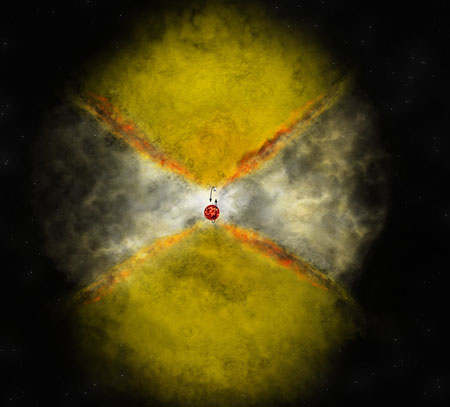| Oct 09, 2014 |
Zeroing in on a source of gamma rays
|
|
(Nanowerk News) Gamma rays are the highest-energy form of radioactive waves known in the universe. However, how they’re made and where they come from have been a bit of a mystery.
|
|
But now a team of researchers, led by Michigan State University astronomer Laura Chomiuk, has made a discovery that may shed some light on the subject.
|
|
Using highly detailed radio telescope images, Chomiuk and her team have pinpointed the location where an explosion on the surface of a star, known as a nova, emitted gamma rays.
|
|
This, said Chomiuk, is something they did not expect to encounter.
|
|
“We not only found where the gamma rays came from,” she said, “but also got a look at a previously unseen scenario that may be common in other nova explosions.”
|
|
The research is detailed in the current issue of Nature ("Binary orbits as the driver of γ-ray emission and mass ejection in classical novae").
|
 |
| In this artist’s rendering, the yellow depicts the material that is expelled just days after the stellar explosion. (Illustration: Bill Saxton, NRAO/AUI/NSF)
|
|
A nova occurs in a star that is part of a binary system – two stars orbiting one another. One star, known as a dense white dwarf, steals matter from the other and the interaction triggers a thermonuclear explosion that flings debris into space.
|
|
It was from this explosion from a system known as V959 Mon, located some 5,000 light years from Earth, that the researchers think the gamma rays were emitted.
|
|
This activity was first detected two years ago by NASA’s Fermi Gamma-ray Space Telescope. Also about that same time similar activity was being picked up by land-based radio telescopes around the world.
|
|
Since that initial detection by Fermi, which occurred in2012, the spacecraft has detected gamma rays from three additional nova explosions in other star systems.
|
|
“This mechanism may be common to such systems,” said Chomiuk. “The reason the gamma rays were first seen in V959 Mon is because it’s closer to us.”
|
|
Because the type of ejection detected in V959 Mon also is seen in other binary star systems, the new insights might help astronomers understand how those systems develop.
|
|
“We may be able to use novae as a ‘testbed’ for improving our understanding of this critical stage of binary evolution,” Chomiuk said.
|
|
Gamma rays can be dangerous and are capable of killing living cells. The medical field uses gamma rays, along with X-rays and other forms of high-energy radiation, to treat cancer.
|
|
Fortunately, by the time gamma rays travel across the universe to us, they are absorbed by the Earth’s atmosphere.
|

